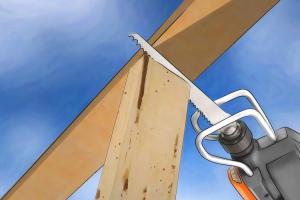Ultimate Guide: How to Spot Termite Damage in Your Home

-
Quick Links:
- Understanding Termites
- Signs of Termite Damage
- How to Inspect Your Home for Termite Damage
- Case Studies of Termite Infestations
- Expert Insights on Termite Prevention
- FAQs
Understanding Termites
Termites are social insects that feed on cellulose, a primary component of wood, paper, and other plant materials. They are often termed “silent destroyers” as they can inflict significant damage to structures without immediate detection. Understanding their behavior and habitat is crucial for spotting signs of infestation early.
Types of Termites
There are three main types of termites:
- Subterranean Termites: Live underground and are the most destructive type. They build mud tubes to reach food sources.
- Drywood Termites: Nest in dry wood and do not require contact with the soil. They are common in warmer climates.
- Dampwood Termites: Prefer moist, decaying wood and are typically found in coastal regions or areas with high humidity.
Signs of Termite Damage
Identifying termite damage early is vital to preventing extensive and costly repairs. Here are common signs to watch for:
Visual Signs
- Wood Damage: Look for hollowed-out wood, which may sound hollow when tapped.
- Frass: Termite droppings resemble sawdust or small pellets and indicate an active infestation.
- Swarmers: Winged termites indicate a nearby colony; they often swarm during spring.
- Mud Tubes: Found on walls or foundations, these tubes protect termites as they travel between their nest and food sources.
Hidden Signs
Termite damage is often hidden from view. Therefore, consider the following:
- Check for peeling paint or bubbling wallpaper, which may indicate moisture and termite activity behind walls.
- Inspect crawl spaces and basements for damp, decayed wood.
- Pay attention to cracks in the foundation as termites can enter through very small openings.
How to Inspect Your Home for Termite Damage
Conducting a thorough inspection is essential. Follow this step-by-step guide to check for termite damage:
Step 1: Gather Tools
You will need:
- Flashlight
- Flathead screwdriver or knife
- Protective gloves
- Notepad for taking notes
Step 2: Inspect the Exterior
Start outside your home:
- Check for mud tubes on the foundation, especially near wood structures.
- Inspect wooden fences, decks, and trees for signs of damage.
- Look for any signs of wood decay or moisture.
Step 3: Inspect the Interior
Move indoors and inspect:
- Basements and crawl spaces for damp wood and mud tubes.
- Walls, ceilings, and floors for any signs of damage, including soft spots.
- Behind furniture and fixtures, especially in corners.
Step 4: Use Professional Help
If you suspect an infestation, consider hiring a pest control professional for a thorough inspection. They can provide an accurate assessment and recommend effective treatments.
Case Studies of Termite Infestations
Understanding real-life examples can help illustrate the seriousness of termite infestations.
Case Study 1: The Smith Family
The Smiths discovered a termite infestation in their home after noticing small piles of frass near their wooden beams. A professional inspection revealed extensive damage, requiring complete replacement of the beams, costing them thousands of dollars.
Case Study 2: The Johnsons
Unlike the Smiths, the Johnsons took proactive measures by regularly inspecting their home. They discovered mud tubes early and were able to treat their home before significant damage occurred, saving on costly repairs.
Expert Insights on Termite Prevention
Experts recommend several strategies to prevent termite infestations:
- Keep wood piles and debris away from home.
- Ensure proper drainage to prevent moisture accumulation.
- Regularly inspect your home, especially during the spring when termites are most active.
Engaging a pest control professional for annual inspections is also advisable for early detection and prevention.
FAQs
1. How can I tell if I have termites?
Look for signs such as mud tubes, frass, hollow-sounding wood, or swarmers around your home.
2. What should I do if I find termite damage?
Contact a pest control professional immediately for an inspection and treatment options.
3. Are termites harmful to humans?
Termites are not harmful to humans but can cause significant structural damage to buildings.
4. How long does it take for termites to cause damage?
Termites can start causing damage within a few months of entering a structure, depending on conditions.
5. What is the best prevention method for termites?
Regular inspections, moisture control, and keeping wood away from the foundation are effective prevention methods.
6. Can I treat termites myself?
While DIY treatments are available, professional treatment is often more effective for severe infestations.
7. How much does termite treatment cost?
The cost can vary widely, ranging from a few hundred to several thousand dollars, depending on the extent of the infestation.
8. What are the signs of a termite infestation?
Look for mud tubes, frass, hollow wood, and signs of swarmers during spring.
9. Do termites only live in wood?
Termites primarily feed on wood and cellulose materials but can also inhabit soil and decaying plant matter.
10. Is termite damage covered by homeowners insurance?
Coverage varies by policy. Check with your insurance provider to understand your coverage options.
Random Reads
- How to view google form responses iphone ipad
- How to remove urine odors and stains permanently
- How to make money in stick rpg
- How to quickly turn copper darker
- How to remove system volume information folder
- Seamless flat panel tv installation
- Scan qr codes from pictures
- How to make a treehouse in minecraft
- How to make a youtube poop
- Open internet explorer